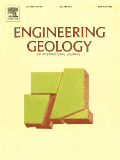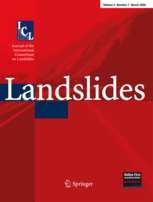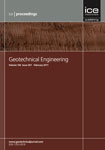
ENGINEERING GEOLOGY
Scope & Guideline
Elevating Standards in Geotechnical Assessments
Introduction
Aims and Scopes
- Geotechnical Characterization of Soils and Rocks:
Research that focuses on understanding the physical and mechanical properties of various soil and rock types, including their behavior under different environmental conditions and loading scenarios. - Landslide and Slope Stability Analysis:
Studies that analyze the mechanisms and factors influencing landslides and slope stability, incorporating field data, numerical modeling, and laboratory experiments. - Seismic Hazard Assessment and Mitigation:
Investigations into the impact of seismic activity on geological formations and infrastructure, including the development of models for predicting seismic responses and the assessment of vulnerability. - Hydro-mechanical Interactions:
Research exploring the interactions between hydraulic and mechanical processes in geological materials, particularly under conditions of saturation, drainage, and pore pressure variations. - Geohazard Monitoring and Risk Assessment:
Studies focused on the monitoring and assessment of geological hazards such as landslides, rockfalls, and sinkholes, utilizing advanced technologies like remote sensing and geophysical methods. - Innovative Engineering Solutions:
Development and evaluation of engineering solutions for mitigating geohazards, including the use of bioengineering, geosynthetics, and advanced construction techniques.
Trending and Emerging
- Machine Learning and Artificial Intelligence Applications:
There is an increasing trend towards incorporating machine learning and AI techniques in geological modeling, risk assessment, and prediction of geohazards, enhancing the accuracy and efficiency of analyses. - Climate Change Impact Assessments:
Research addressing the implications of climate change on geological processes, including landslide susceptibility, soil erosion, and groundwater dynamics is becoming more prominent. - Integrated Geophysical and Geotechnical Approaches:
Emerging methodologies that combine geophysical surveys with geotechnical assessments are gaining traction, allowing for more comprehensive site characterizations. - Sustainable Engineering Practices:
There is a growing emphasis on sustainable practices in engineering geology, including the use of eco-friendly materials and methods that reduce environmental impacts. - Real-Time Monitoring Technologies:
The use of real-time monitoring technologies, including fiber optics and remote sensing, for assessing and predicting geohazards is increasingly featured in recent studies. - Hydrogeological Modeling:
Research focusing on the hydrogeological aspects of engineering geology, particularly the interactions between groundwater and geotechnical stability, is on the rise.
Declining or Waning
- Traditional Rock Mechanics:
Research that primarily focuses on classical rock mechanics without the integration of modern computational methods or interdisciplinary approaches appears to be declining, as more innovative techniques gain traction. - Static Geotechnical Assessments:
The emphasis on static assessments of soil and rock properties is decreasing in favor of dynamic and time-dependent analyses that consider the influence of changing environmental conditions. - Conventional Laboratory Testing Methods:
There is a trend away from conventional laboratory testing methods in favor of more advanced techniques, such as in-situ testing and non-destructive methods that provide real-time data. - Single-Factor Risk Analysis:
Research focusing on single-factor analyses for assessing geohazards is waning, with a growing emphasis on multi-factor and probabilistic approaches that better capture the complexity of geological systems.
Similar Journals

Landslides
Elevating Academic Discourse in Geotechnical EngineeringLandslides, published by Springer Heidelberg, is a premier journal in the field of Geotechnical Engineering and Engineering Geology, distinguished by its impressive Q1 quartile ranking in 2023. With its focus on advancing knowledge related to landslides—covering origins, mechanics, risk assessment, and mitigation strategies—this journal serves as an essential resource for researchers, professionals, and students alike. Spanning from 2004 to 2024, it emphasizes interdisciplinary approaches, employing cutting-edge research and methodologies to address the complexities of landslide phenomena. The journal's exceptional standing is further evidenced by its Scopus rank of 4 out of 229 in its category, placing it in the 98th percentile of its field. Although it is not an open-access publication, Landslides provides invaluable insights and significant contributions to the global understanding of geotechnical challenges, making it a vital platform for disseminating research and fostering academic discourse in this critical area.

Acta Geotechnica Slovenica
Unveiling Insights into Geotechnical Challenges.Acta Geotechnica Slovenica is a distinguished peer-reviewed journal published by the University of Maribor, Slovenia, that focuses on the fields of geology, geophysics, and geotechnical engineering. With an ISSN of 1854-0171, it showcases significant research contributions that enhance our understanding of geotechnical challenges and innovations. The journal has been active since 2008 and has gained recognition within the academic community, holding a Q3 quartile ranking in Geology and a Q4 ranking in Geophysics and Geotechnical Engineering and Engineering Geology as per the 2023 categorization. Even though there are no Open Access options available, the journal remains an important resource for researchers, professionals, and students alike, serving as a platform for disseminating impactful findings in earth science disciplines. Its relevance is underscored by its rankings in Scopus, positioning it among the notable journals in its field. Engaging with Acta Geotechnica Slovenica offers an invaluable opportunity to stay at the forefront of geotechnical research and advancements.

PROCEEDINGS OF THE INSTITUTION OF CIVIL ENGINEERS-GEOTECHNICAL ENGINEERING
Advancing Geotechnical Knowledge for Tomorrow's InfrastructurePROCEEDINGS OF THE INSTITUTION OF CIVIL ENGINEERS-GEOTECHNICAL ENGINEERING, published by Emerald Group Publishing Ltd, is a prestigious journal that serves the dynamic field of geotechnical engineering and broader earth sciences. With an ISSN of 1353-2618 and an E-ISSN of 1751-8563, this journal has established itself as a vital resource for researchers, professionals, and students alike, offering insights into innovative practices and developments within the geotechnical domain. It ranks within the Q2 category for Earth and Planetary Sciences and Geotechnical Engineering as of 2023, demonstrating its significant impact and relevance in these fields. Given its comprehensive scope from 1994 to 2024, the journal provides a platform for high-quality research articles, case studies, and technical notes, although it presently does not offer open access options. Researchers seeking to publish their work will find this journal an essential venue for reaching an audience deeply invested in the advancement of geotechnical methodologies and solutions.

Italian Geotechnical Journal-Rivista Italiana di Geotecnica
Elevating Standards in Geotechnical Research and Practice.Italian Geotechnical Journal-Rivista Italiana di Geotecnica, published by PATRON EDITORE S R L, is a rigorously peer-reviewed journal dedicated to advancing the field of geotechnical engineering and engineering geology. With a history dating back to 1976 and an active publication span from 2011 to 2024, the journal provides a vital platform for researchers and practitioners to disseminate innovative findings and methodologies in the field. Although it currently holds a Q4 category ranking in Geotechnical Engineering and Engineering Geology, the journal is committed to maintaining high academic standards and quality of publication. Its Scopus ranking places it within the 29th percentile of Earth and Planetary Sciences, indicating its significance among scholarly publications. The Italian Geotechnical Journal serves not only as a resource for academic inquiry but also as an essential tool for professionals seeking to stay abreast of the latest developments and applications in geotechnical research. This journal is essential for students and researchers aiming to deepen their knowledge and contribute to ongoing discourse in geotechnics.

Bulletin of Engineering Geology and the Environment
Bridging theory and practice in the geological sciences.Bulletin of Engineering Geology and the Environment, published by SPRINGER HEIDELBERG, is a leading journal dedicated to the fields of Geology, Geotechnical Engineering, and Engineering Geology. With an impressive impact factor placing it in the Q1 category for both geology and geotechnical disciplines, this journal is recognized for its significant contributions to the knowledge and application of engineering geology practices. Since its inception in 1984, the Bulletin has provided a platform for researchers and professionals to share cutting-edge research, case studies, and innovative methodologies relevant to the challenges of understanding and managing geological environments. With a robust Scopus ranking—#32/321 in Geology and #43/229 in Geotechnical Engineering—this journal is an essential resource for academics and industry leaders alike, striving to advance the environmental engineering field. For those interested in accessing the latest research and developments, the Bulletin fosters a collaborative and informed scholarly community.

Geodynamics & Tectonophysics
Fostering Collaboration in Geophysical ResearchGeodynamics & Tectonophysics, published by the esteemed Russian Academy of Sciences, Siberian Branch, Inst Earths Crust, is a pivotal open-access journal that has been contributing to the scientific discourse on Earth's dynamic processes since 2010. With an ISSN of 2078-502X, this journal serves as a vital platform for researchers and professionals interested in the fields of Earth-Surface Processes, Economic Geology, Geology, and Geophysics, holding a Q3 ranking in each of these categories as of 2023. The journal is based in Irkutsk, Russia, and encompasses a broad spectrum of topics, fostering interdisciplinary collaboration and innovation. Researchers can access cutting-edge studies and insights, engaging with a community committed to advancing our understanding of geodynamics and tectonic phenomena. With a sustained commitment to quality and accessibility, Geodynamics & Tectonophysics plays a critical role in addressing pressing geological concerns and advancing global geological research.

Geotechnique Letters
Exploring the Depths of Geotechnical Research.Geotechnique Letters is a prestigious journal published by Emerald Group Publishing Ltd, with a focused dedication to advancing the field of geotechnical engineering and engineering geology. Since its inception in 2011, the journal has rapidly established itself as a leading platform for disseminating high-quality research and innovative practices, earning a stellar Q1 ranking in both Earth and Planetary Sciences (miscellaneous) and Geotechnical Engineering categories as of 2023. With an ISSN of 2049-825X and E-ISSN 2045-2543, this journal captures vital insights and cutting-edge developments that cater to researchers, industry professionals, and students passionate about geotechnical challenges. Although it operates under a subscription model, the journal offers options for authors to publish their work—enhancing accessibility for those seeking to share knowledge within the community. The Scopus rankings place it comfortably within the top echelons of its field, affirming its importance and influence in shaping the future of geotechnical research and practice. With converged years extending to 2024, Geotechnique Letters is positioned as an essential resource for anyone looking to stay atop advancements and discussions in geotechnical sciences.

Geam-Geoingegneria Ambientale e Mineraria-Geam-Geoengineering Environment and Mining
Advancing sustainable practices in geoengineering and mining.Geam-Geoingegneria Ambientale e Mineraria (Geam-Geoengineering Environment and Mining), published by PATRON EDITORE S R L in Italy, is a pivotal journal dedicated to the intersection of environmental engineering, geotechnical engineering, and engineering geology. With an ISSN of 1121-9041, this journal has been a key source of valuable research since 2007, fostering the dissemination of knowledge within these critical fields. Despite its current ranking in the Q4 category for both Environmental Engineering and Geotechnical Engineering in 2023, the journal aims to elevate its standing by promoting high-quality submissions that address pressing issues related to sustainable geoengineering practices and environmental impacts of mining activities. Although not an open-access journal, Geam-Geoingegneria Ambientale e Mineraria offers insights that are crucial for professionals, researchers, and students looking to contribute to the advancement of geoengineering approaches and their implications for both the environment and mining industries. As it continues to bridge theoretical frameworks with practical applications, the journal stands as an important avenue for scholarly discourse and innovation in these domains.

ENVIRONMENTAL & ENGINEERING GEOSCIENCE
Elevating Geoscience Research for Environmental ImpactENVIRONMENTAL & ENGINEERING GEOSCIENCE, published by the Geological Society of America, Inc, is an esteemed peer-reviewed journal duly established to advance the fields of geotechnical engineering, environmental engineering, and broader earth sciences. With an ISSN of 1078-7275 and an E-ISSN of 1558-9161, this journal disseminates high-quality research and innovative methodologies that address pressing environmental issues and engineering challenges. As of 2023, it is classified in the Q3 category across various disciplines within earth and planetary sciences, highlighting its contribution and relevance within the academic community. The journal boasts an impactful trajectory, converging research from 1995 to 2024, and is strategically positioned to facilitate the exchange of ideas among researchers, practitioners, and students alike. With a commitment to fostering an understanding of geosciences in relation to environmental engineering, this journal is a valuable resource for those dedicated to developing sustainable solutions in our ever-evolving landscape. Readers can access published works through institutional libraries or relevant academic platforms, ensuring that groundbreaking research reaches all corners of the discipline.

Seismic Instruments
Elevating the understanding of seismic activity through collaboration.Seismic Instruments is a prestigious academic journal dedicated to advancing the field of geophysical instrumentation and its applications in seismic studies. Published by PLEIADES PUBLISHING INC, this journal serves as a crucial resource for researchers, professionals, and students interested in the development, evaluation, and deployment of seismic instrumentation technologies. Although it does not currently offer open access, it provides a comprehensive platform for high-quality research articles, reviews, and technical notes that explore the latest innovations and findings in seismic studies. With an ISSN of 0747-9239 and an E-ISSN of 1934-7871, Seismic Instruments aims to foster collaboration and knowledge exchange among the global academic community, emphasizing the importance of instrumentation in understanding seismic activity and its implications for engineering, environmental science, and hazard mitigation.